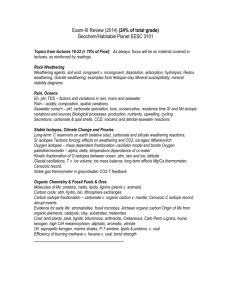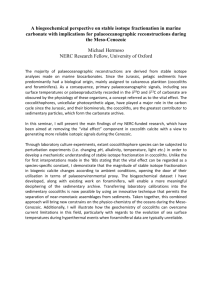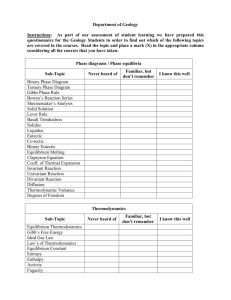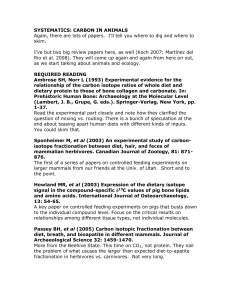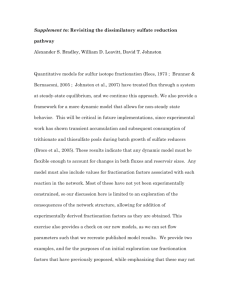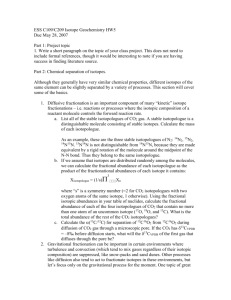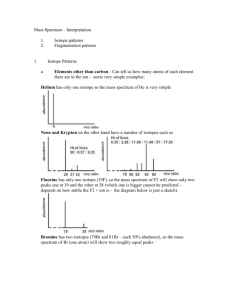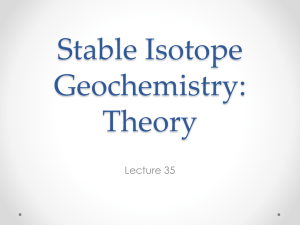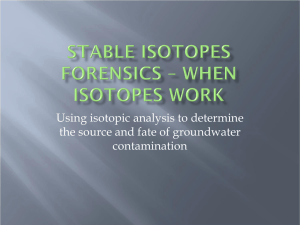Chapter 7 problems
advertisement
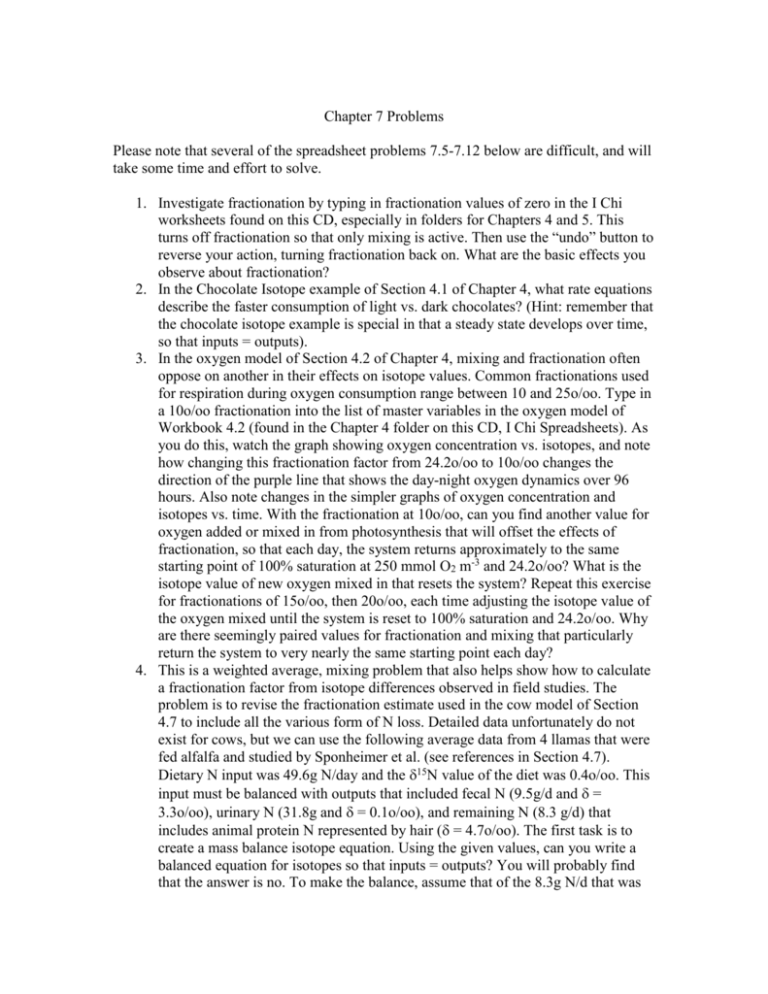
Chapter 7 Problems Please note that several of the spreadsheet problems 7.5-7.12 below are difficult, and will take some time and effort to solve. 1. Investigate fractionation by typing in fractionation values of zero in the I Chi worksheets found on this CD, especially in folders for Chapters 4 and 5. This turns off fractionation so that only mixing is active. Then use the “undo” button to reverse your action, turning fractionation back on. What are the basic effects you observe about fractionation? 2. In the Chocolate Isotope example of Section 4.1 of Chapter 4, what rate equations describe the faster consumption of light vs. dark chocolates? (Hint: remember that the chocolate isotope example is special in that a steady state develops over time, so that inputs = outputs). 3. In the oxygen model of Section 4.2 of Chapter 4, mixing and fractionation often oppose on another in their effects on isotope values. Common fractionations used for respiration during oxygen consumption range between 10 and 25o/oo. Type in a 10o/oo fractionation into the list of master variables in the oxygen model of Workbook 4.2 (found in the Chapter 4 folder on this CD, I Chi Spreadsheets). As you do this, watch the graph showing oxygen concentration vs. isotopes, and note how changing this fractionation factor from 24.2o/oo to 10o/oo changes the direction of the purple line that shows the day-night oxygen dynamics over 96 hours. Also note changes in the simpler graphs of oxygen concentration and isotopes vs. time. With the fractionation at 10o/oo, can you find another value for oxygen added or mixed in from photosynthesis that will offset the effects of fractionation, so that each day, the system returns approximately to the same starting point of 100% saturation at 250 mmol O2 m-3 and 24.2o/oo? What is the isotope value of new oxygen mixed in that resets the system? Repeat this exercise for fractionations of 15o/oo, then 20o/oo, each time adjusting the isotope value of the oxygen mixed until the system is reset to 100% saturation and 24.2o/oo. Why are there seemingly paired values for fractionation and mixing that particularly return the system to very nearly the same starting point each day? 4. This is a weighted average, mixing problem that also helps show how to calculate a fractionation factor from isotope differences observed in field studies. The problem is to revise the fractionation estimate used in the cow model of Section 4.7 to include all the various form of N loss. Detailed data unfortunately do not exist for cows, but we can use the following average data from 4 llamas that were fed alfalfa and studied by Sponheimer et al. (see references in Section 4.7). Dietary N input was 49.6g N/day and the value of the diet was 0.4o/oo. This input must be balanced with outputs that included fecal N (9.5g/d and = 3.3o/oo), urinary N (31.8g and = 0.1o/oo), and remaining N (8.3 g/d) that includes animal protein N represented by hair ( = 4.7o/oo). The first task is to create a mass balance isotope equation. Using the given values, can you write a balanced equation for isotopes so that inputs = outputs? You will probably find that the answer is no. To make the balance, assume that of the 8.3g N/d that was not excreted, only 6.3g N/d was in fact gained by the animal, but a small and hard-to-measure amount of 2g N/d was lost as N2 gas via denitrification, an anaerobic respiration occurring in the guts of the animals. Now recalculate the mass balance, and determine the 15N value of nitrogen lost during denitrification. Next, using the value of 6.3g N/d assimilated into animal protein, what is the overall N retention efficiency and what is the fraction lost? Using the top line of the diagram Fig. 7.5, the value just calculated for the fraction lost, and the 4.7o/oo 15N value for hair that represents the “residue” not lost but retained by the llamas, what is the average fractionation value for the total losses? You can substitute this newly calculated value for the 9o/oo value used in the cow model of section 4.7 for more realistic simulations of cow isotopes during pasture grazing. 5. Imagine a whale that each year migrates from the arctic in the summer to the equator in the winter and then back again to the arctic. Some whales actually make such annual migrations. Further, whale food had 13C values of -25o/oo in the arctic and -15o/oo at the equator. Draw a diagram and develop a day-by-day spreadsheet model of how isotopes in food will change over time during the course of an annual migration, then replicate this cycle for 5 years. Use this 5-year food isotope projection and I Chi modeling to calculate isotope values in whale blood (a low-mass, fast turnover tissue) and whale blubber (a high mass, slow turnover tissue) during the annual migration cycle. (Hint: section 5.9 shows a tissue turnover example). Allow for tissue turnover, mass loss and fractionation during tissue turnover, even as the whale is growing with a net gain mass. 6. Use the oxygen model presented in Section 4.2 and in Workbook 4.4, worksheet 10 (see Chapter 4 folder on this CD, I Chi Spreadsheets), and link a CO2 model to the oxygen dynamics. That is, when photosynthesis produces one unit of oxygen, it also consumes one unit of dissolved CO2. And conversely, when respiration consumes one unit of oxygen, one unit of CO2 is generated. The linkage should thus exist at a molar ratio of 1:1 for O2: CO2 in respiration and in net photosynthesis. Assume that the CO2 pool is represented as DIC (dissolved inorganic carbon) in the sea with an initial concentration of 2000 mmol m-3, and the carbon isotope composition of the initial DIC is 1.0o/oo DI13C. 7. You are working in a lake ecosystem, trying to understand dynamics of plant production by studying oxygen isotopes (18O). You begin thinking about a closed system with just photosynthesis during the day, and respiration day and night. Assume that the isotope value of newly-produced photosynthetic oxygen is 0o/oo, the initial isotope value of oxygen in the water is 24.2o/oo, and that the initial concentration of oxygen is 250 mmol m-3. Develop an I Chi model for 24 hours of oxygen cycling (a day-night model), with midnight as your initial time point. Make graphs that show a) oxygen concentrations over the day-night cycle, and b) isotope compositions of that oxygen. Use a fractionation factor of = 18o/oo for fractionation during respiration. (Hint: see Section 4.4 for help with a basic I Chi model for oxygen dynamics). The rest of this problem involves expanding this basic I Chi model to include three more processes: equilibrium with the atmosphere, exchange with the atmosphere, and oxygen injection during storms via bubbles. a. Equilibrium with the atmosphere. When plants produce oxygen in the day by photosynthesis, this often leads to oxygen supersaturation and loss of oxygen to the atmosphere. But respiration also consumes oxygen, so that oxygen can become undersaturated especially at night, and oxygen will begin invading from the atmosphere. Overall, the atmosphere buffers the lake system, bringing it back towards an equilibrium or saturated oxygen concentration value, assumed to be 250 mmol m-3 in this example. Add the processes of invasion and evasion to your model, assuming that invasion introduces oxygen with an isotope composition of 24.2o/oo and that evasion occurs without isotope fractionation ( = 0o/oo). Then explore daily results for concentrations and isotopes in a eutrophic system with abundant photosynthesis and respiration vs. in an oligotrophic system that is fairly unproductive for both photosynthesis and respiration. What are the effects of the higher rates of invasion and evasion for the eutrophic system? b. Exchange. Think about the effects of winds that stir the surface of the lake and lead to exchange of oxygen between the water and atmosphere, with exchange occurring continually when oxygen concentrations are at saturation. Concentrations don’t change, but isotopes do change during this exchange process. Assume that exchange introduces oxygen with 18O = 24.2o/oo into the water, and that exchange only occurs at saturation, with evasion and invasion dominating when concentrations are above or below saturation. What happens when photosynthesis = respiration in the presence and absence of exchange? c. Oxygen injection. Storms re-equilibrate oxygen concentrations and isotopes in the dissolved oxygen pool, actually leading to a mild 103% supersaturation characteristic of many low-productivity aquatic systems. Add the possibility of bubble injection into the model, then explore two scenarios for stormy (large amounts of bubble injection) and calm (low amounts of bubble injection) conditions. 8. You are working on climate models and want to understand the history of carbon isotopes (13C) in CO2. Analyses of air trapped in ice cores show an historical overview of this dynamic. Especially, you learn that in the year 1800, the isotope composition of CO2 in global air was -6.5o/oo and CO2 at that time had a concentration of 260ppm. Today you measure the outside air and find a concentration of 375ppm, and you read that combustion of fossil fuel is responsible for the increase in concentration. If fossil fuel (mostly oil) has a 27o/oo 13C value, and there is no fractionation during various combustion scenarios (in cars, factories, etc.) that produce CO2 from fossil fuels, what would you expect is the 13C value of CO2 in today’s air? Next, you read that CO2 in air exchanges with a much larger amount of CO2 and bicarbonate in the ocean, buffering large changes in atmospheric CO2 concentration. Exchange involves losing CO2 from the air to the ocean, but also regaining CO2 to the atmosphere from the ocean, in a balanced way that does not change amounts, but could affect isotopes. The large, buffered ocean will emit CO2 that is currently mostly equilibrated with pre-industrial conditions, and this CO2 emitted from the ocean will have a -6.5o/oo value. You begin to think about what this exchange might mean for isotopic values, use I Chi modeling to show the time course of CO2 concentrations and isotopic values of CO2 over time. Show these graphs for 2 scenarios, a) assuming no exchange with the ocean, and b) assuming that the atmosphere exchanges with the oceanic carbon pool each year, so that the predicted outcome of the modeling for the year 2004 is 375ppm atmospheric CO2 with a value of -8o/oo. 9. Develop an I Chi spreadsheet model for a continuous culture, flow-through system used for growing microbes. Fluid drips in continuously to an open vat that is well-stirred, then flows out so that inputs = outputs. Microbes grow and use up part of the nutrients supplied, so that amounts stabilize as a balance of input and uptake. 10. Develop a nitrogen isotope I Chi spreadsheet model for a food web in the upper ocean. Simplify the food web to include only three components, nitrate, phytoplankton, and zooplankton. Nitrogen can be lost from the upper ocean pools of phytoplankton and zooplankton pools but then re-enter the nitrate pool as regenerated nitrate. Nitrogen can also be lost to the deeper ocean via sinking of phytoplankton and zooplankton. New sources of nitrate can include upwelling of deep water and nitrogen fixation. Nitrate can also be removed by denitrification. Hint: be sure to diagram this model before beginning. Also, for the “N lost” or (= “product lost”) from zooplankton and phytoplankton compartments, you will need to use the equation for the product lost or formed (see Sections 4.4, 7.1) when recirculating or regenerating this N from phytoplankton and zooplankton back into the nitrate pool. Assume no fractionation during the regeneration process. 11. Take a minute to reread the first part of Section 7.5 before you start work on this problem. Consider the Pacific landscape of Section 7.5, where 15N values of nitrate and particulate organic nitrogen (PON) increase as nitrate-rich water upwells at 2oS and moves north. Develop a spatial I Chi model for predicting this change in 15N from 2oS to 24oN, with changes in nitrate 15N modeled at 1o intervals of latitude as water moves north from its point of upwelling. Use a fractionation factor of = 5o/oo for nitrate consumption, and use closed-system equations for nitrate isotopic compositions and PON (see Fig. 7.4 for equations; nitrate = residual reactant and PON = instantaneous product), with a) nitrate modeling focused on upwelled nitrate and assuming no new nitrate inputs and b) PON modeling assuming that PON formed is grazed and remains at the latitude in which it is formed, and does not move north with water and nitrate. Also assume that as water moves north, there is an increasing amount of new “gyre” N added via a combination of local recycling and N fixation, with a net isotope value of 3o/oo. Can you use your model to predict 15N values of sedimentary PON, assuming a 6o/oo increase in 15N values from surface PON to sediment PON? 12. Take a minute to reread the latter part of Section 7.5 before you start work on this problem. Consider the muddy floor of the ocean, as presented in Section 7.5. Think about sulfate dynamics as sulfate diffuses into the mud from a large reservoir of sulfate in bottom waters. Bacteria in the sediments consume sulfate as it diffuses downwards, with isotope fractionation during sulfate reduction to sulfide. Develop an I Chi model for this process as a closed system reaction with increasing depth, involving sequential sulfate removal and fractionation as sulfate diffuses downwards. Then develop a second related model that is more complex and allows for three types of mixing at larger and smaller scales: bioturbation mixing, diffusion and exchange. At the largest scale, bioturbation by burrowing animals will mix sulfate from one interval with sulfate from the interval above it. Set up this mixing so that 0-100% of the sulfate in an interval can mix with the sulfate in the interval above it. The second type of mixing is at a smaller scale, via diffusion. Diffusion also resupplies sulfate, but with isotope fractionation that develops in response to gradients developed by sulfate reduction (see Jorgensen 1979 and Chanton et al. 1987 references in Section 7.5). Set up this diffusional mixing so that 0-100% of the sulfate lost to sulfate reduction in an interval can be resupplied from the interval above it, with a characteristic isotopic fractionation. Lastly, exchange at the molecular level could possibly mix sulfate without changing concentrations, only isotopes. Set up this mixing so that 0-100% of the sulfate in an interval can exchange with the sulfate in the interval above it. For all models, plot the sulfate concentrations and isotopes vs. depth, and make an (x,y) plot of (-ln(concentration), 34S). This last (x,y) plot gives the permil fractionation factor as the slope of the line (i.e., slope = ). Once the models are constructed, the task is to compare results of the two models, remembering that the first model is a simple closed system model, and the second model is similar but more complex in that it also allows up to three types of extra mixing. Can you adjust the sulfate concentration profiles so that they are equal for the two models, but there is extra sulfate entering the system in the mixing model? What happens to fractionation in this case measured as values? If you now further allow exchange, what happens to fractionation? (Note: when you make these comparisons, the fractionation in any diffusional mixing should be the last thing you adjust, because it is determined from the isotope gradient that develops from the main sulfate reduction process. The fractionation here is not independent of the main isotope gradient, and you have to adjust it to bring the system to balance. It is the author’s experience that this adjusted fractionation should match the overall fractionation calculated from the plot of (ln(concentration), 34S) for downward diffusing sulfate. Can you adjust the fractionation in the diffusion step until it matches the fractionation calculated from that plot? When you have done this, this second, more complex model is balanced and complete). 13. Here is a list of isotope cycling papers - can you recast any one of these studies in terms of I-Chi and get the same answers? (Note: no answers are provided in this book for these challenging papers): Altabet, M.A. 1988. Variations in nitrogen isotopic composition between sinking and suspended particles: implications for nitrogen cycling and particle transformation in the open ocean. Deep-Sea Research 35:535-554. Cline, J.D. and I.R. Kaplan. 1975. Isotopic fractionation of dissolved nitrate during denitrification in the eastern tropical North Pacific Ocean. Marine Chemistry 3:271-299. Goldhaber, M.B. and I.R. Kaplan. 1980. Mechanisms of sulfur incorporation and isotope fractionation during early diagenesis in sediments of the Gulf of California. Marine Chemistry 9:95-143. Kroopnick, P. and H. Craig. 1976. Oxygen isotope fractionation in dissolved oxygen in the deep sea. Earth and Planetary Science Letters 32:375-388. Macko, S.A., M.L. F. Estep, M.H. Engel and P.E. Hare. 1986. Kinetic fractionation of stable nitrogen isotopes during amino acid transamination. Geochimica et Cosmochimica Acta 50:2143-2146. Uhle, M.E., S.A. Macko, H.J. Spero, D.W. Lea, W.F. Ruddiman and M.H. Engel. 1999. The fate of nitrogen in the Orbulina universa foraminifera-symbiont system determined by nitrogen isotope analyses of shell-bound organic matter. Limnology and Oceanography 44:1968-1977. Voss, M., J.W. Dippner and J.P. Montoya. 2001. Nitrogen isotope patterns in the oxygen-deficient waters of the Eastern Tropical North Pacific Ocean. DeepSea Research I 48:1905-1921.
